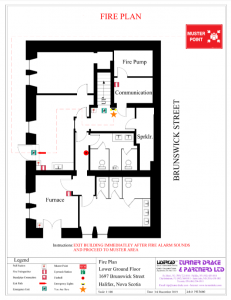
Fire Emergency Floor Plans form part of the “Fire Safety Plan”, a document mandated by the National Fire Code for all buildings that are required to have a fire alarm system under the National Building Code. They include virtually all buildings with sprinkler systems; and non-sprinklered buildings over three storeys (basements count as storeys) or which meet specified minimum occupant loads. The Fire Safety Plan document (really a booklet… Halifax Regional Municipality’s version runs to 42 pages plus addenda) has to be approved and registered with the appropriate fire prevention authority and is building specific. It includes an audit of the building resources and their location (heating system; main gas shutoff; etc.), an audit of the human resources and contact information (owner; manager; fire alarm, sprinkler and extinguisher monitoring and servicing companies), emergency procedures, responsibilities of owner/occupant, fire hazards, fire drills, fire extinguishers, and so on, together with a temporal assignment of duties to ensure that the safety equipment is checked in a timely manner. A copy of the Fire Safety Plan has to be left on site in a location registered with the fire prevention authority (usually in the fire panel) for reference by the fire department in the event of a fire. The Fire Emergency Floor Plans are a critical part of the Fire Safety Plan since they show the location of the building fire emergency systems (detection and fighting equipment) such as emergency lights, exit signs, pull stations, fire extinguishers, hose cabinets, bells, sirens, smoke and heat detectors, gas and sprinkler shut off valves, electrical shut off switch, pull pins for kitchen fire suppression systems, standpipes, fire panel, fire pump, fire department connections, and sprinkler riser. Since the Fire Emergency Floor Plans form part of the Fire Safety Plan, a legal requirement, they must be prepared if the building does not have them, or if they are out of date because the building has been altered, or the fire equipment has been changed. We utilize our “As Built” plans as a base and map the fire emergency systems onto them. This is the most cost effective way of preparing Fire Emergency Floor Plans.
Fire Evacuation Plans form part of the wayfinding signage posted throughout the building’s common areas and show the safe evacuation route out of the building in the event of a fire. They indicate the exits, evacuation route, muster point and the type and location of firefighting equipment (pull stations, fire extinguishers, hose cabinets). The 2020 National Fire Code requires Fire Evacuation Plans in every hotel and motel bedroom. They are not legally required but may be posted in apartment, office, retail and institutional buildings as an aid to ensure safe evacuation when the route is complex and/or is not readily apparent from the exit signage.